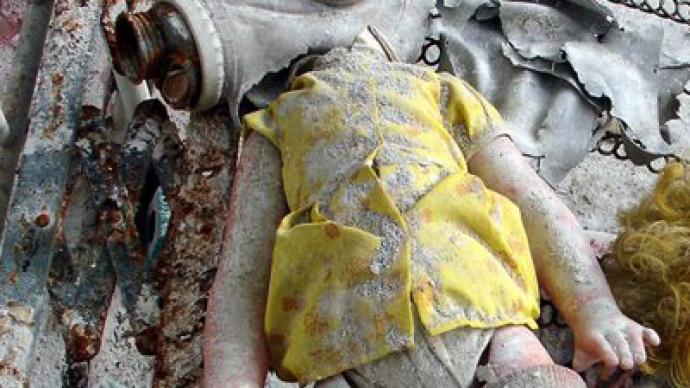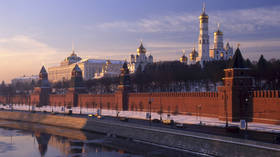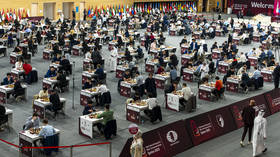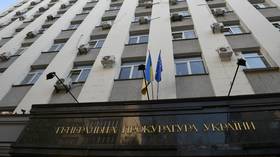Dreadfully appealing – a place where Geiger counter goes mad

The Chernobyl zone is to be officially opened for tourists in 2011. According to Ukrainian news agencies, safe routes have been developed and are ready to be operated.
“Guides, together with medical workers, have already prepared a safe itinerary for visitors,” says Oksana Nor, director of the state-run “ChernobylInterInform” news agency.The idea to open a new tourist attraction appeared alongside the keen interest that the abandoned town provoked in foreigners. According to Forbes magazine, Chernobyl is in the top ten most interesting places in the world.
“We need to demonstrate that Ukraine no longer presents a radioactive threat to people. Visitors will hear the whole story of the Chernobyl disaster, of rectification of the consequences and much more,” Nor points out.The Ukrainian Ministry of Emergency Situations stated, though not officially, that radiation pollution in the exclusion zone bears spot character, with some places being unsafe to stay at, while others constitute no significant danger to health. “The itineraries developed in Chernobyl are harmless,” the authorities declare.
Radioactive tour
Ukrainian authorities hope that the tour will become one of the main sightseeing hits in the country. The first excursion will take place during the New Year holidays, and visitors are promised a fireworks display near the atomic power station’s sarcophagus. Despite the fact that it is only now that such excursions have become legally permissible, small private travel bureaus have been offering tours to the radioactive zone for the past several years. Such tours include a four or five-hour walk and cost approximately US$100 per person. But the illegal tours could be quite dangerous – guides may forget to warn tourists there are spots marked by high radiation levels, and lingering there without taking precautions may lead to serious consequences and even to radiation sickness.Official tourist agencies also organize such tours; though they do not advertise them on their websites. If you decide to ignore the official excursions or just do not want to wait for another month, you may try your luck and give a tourist company a call.A livejournal [Russian blog site] user from St. Petersburg, Aleksandr Durnev, an enthusiastic blogger and traveler, was one of the first to go to Chernobyl on an illegal tour which he found difficult to forget. He described the excursion in the livejournal blog he keeps in Russian, illustrating his story with pictures many might find depressing and shocking. Officially it is forbidden to take pictures during excursions. The only place where photography is not banned is the observation point of the notorious sarcophagus. Still, the Internet is full of pictures taken from all over the ghost town at the photographers’ own risk.The first radioactive zone border lies some 180 kilometers away from Kiev. There, at a big checkpoint, men dressed in military uniform examine passports and let tourists in for a small additional fee. Ten kilometers further on, there is a second checkpoint with more-or-less the same security measures. When you pass this checkpoint, you find yourself in Chernobyl. “The sight was horrifying and shocking – dead silence, empty dark windows broken into tiny pieces of glass, trees growing through half destroyed roofs,” recalls Aleksandr.A village called Kopachi, a small hamlet nearest to Chernobyl, looks like a big graveyard. After the explosion, this place was considered extremely “dirty” – the level of radiation was appalling, so several dozen bulldozers buried all the houses, turning the village into a row of tombs. “The next so-called place of interest we were taken to was a big pond (a former reactor coolant) that is now inhabited by catfish. Huge four-meter long fish emerged to the surface when somebody threw a piece of bread to the water (note that normally these fish do not grow bigger than two meters!),” recounted the blogger. Another notorious ghost town where tourists are taken after Chernobyl is the town of Pripyat. Located just four kilometers away from the actual accident scene, it is the second famous tourist site. No one lives there. The houses, schools, hospitals and post offices are silent and deserted.
The atmosphere is oppressing and ominous, something you would expect reading another Dean Koontz novel, shivering. Aleksandr wrote in his blog: “First we went to a hotel located on the central city square. The reception desk was covered in a thick layer of dust, and when we ascended to the terrace we saw a birch tree growing from the floor. Then we were taken to a former amusement park with lots of attractions that looked horrifying. There is no need to describe all the sites we saw in Pripyat – they differed solely in the degree of shock and terror they produced.” At the end of the excursion, tourists are allowed to wander for some time on their own under the supervision of the guides who clamp down on any attempt to march off the itinerary’s trail.After the tour, visitors are normally asked to return to the checkpoint where they pass radiation-measuring control. If anyone is believed to have got too “dirty”, he or she leaves their boots at the checkpoint and has to return home in socks.And this is where the tour comes to an end.There is a canteen some 25 kilometers away from the disaster site. All goods are “imported” from Kiev and are not contaminated. By the way, the canteen building is home to about a dozen cats, which proves the place is actually not a dead zone. A few kilometers away from the city there are dozens of locals who will be happy to feed the tourists. Authorities let them sell home-grown food, and lovers of extreme pursuits might enjoy tasting mushrooms and berries gathered in the nearby forest.
Shoeless but secure
The price for the government approved excursion does not differ greatly from its illegal predecessor – $100 per person. However, not all tourist companies will have the right to organize such tours: there is an array of papers that need to be collected before the permission is obtained. The extreme tour does not allow young people under 18 or pregnant women to visit Chernobyl, and everyone must wear clothes that cover the whole body – no minis or T-shirts are allowed. Authorities are positively sure the excursions pose no threat to the tourists’ health. All in all, the radiation dose tourists get during the excursion is slightly smaller than the one people get during a transatlantic flight and does not exceed 1,000 microroentgens per hour, while the lethal dose equals to 300-500 roentgens per hour.What tourists are seeing now above the destroyed fourth bloc of the Chernobyl NPP is in fact the old, or the original, sarcophagus built in 1986 – just months after the fallout. Today, the highest radiation level (about 1500 microroentgens per hour) is detected only close to the sarcophagus – a huge construction made of armored concrete that contains the smashed reactor. Only there, in the immediate proximity of the sarcophagus, can a person develop acute radiation syndrome. “The closest one can get to the sarcophagus – unless you have special permission (which is practically impossible to obtain for a tourist) – is around a 100 meters,” said Aleksandr.For the past ten years, efforts have been underway to make a new protective cover over the destroyed sarcophagus, which will not only block off the radiation materials, but also let professionals work in close proximity to the sarcophagus – currently a dangerous occupation. The Ukrainian government turned to the EU to build a new confinement shell. French company “Navarco” won the right to build a new structure to cover the reactor. “The protective shelter will present an arch barrel,” said the Ukrainian Ministry of Emergency Situations, “this will ensure that radioactive materials will on no account penetrate into the atmosphere.” And though there were rumors the old construction can no longer restrict radiation and might cause another disaster, the head of the Ukrainian EMERCOM deflated these rumors: “The sarcophagus is in good condition and will guarantee safety until it is replaced with the new one.”A number of medical workers are sure the safety precautions that are taken today are excessive. But too many people are still afraid to set their foot in one of the greatest quarantine areas in human history, and continue to repeat the stories of two-headed birds and gigantic six-legged calves spotted in the zone.
The living monument
For more pictures visit RT's Chernobyl galleryThe Chernobyl that is so appealing for tourists today used to be a simple Ukrainian town with an Atomic Power Station built within its boundaries some 30 years ago. On April 26, 1986, the reactor exploded and a great mass of radioactive substances shot into the atmosphere, making the town a toxic travesty, and the catastrophe the greatest of its kind. Today there are several versions of the reason of the tragedy, one of the most popular being that the reactor failed to meet safety requirements. More than a hundred people died in the three months following the disaster. 134 more suffered from radiation sickness, and more than 4,000 are doomed to die of thyroid cancer. More than 600,000 people took part in remediation process; approximately 115,000 people were evacuated from all the towns and dwellings in the 30-kilometer zone. It took 25 years to turn the place from a toxic town into a dangerous tourist attraction. Huge vegetables and fruit continued to grow in the nearby areas for two-and-a-half decades, and thousands of new babies were born with various defects. Despite the fact that tours and excursions are being organized to Pripyat, the city is unlikely ever to be inhabited again. The fallout period of many radioactive particles in the area amounts to thousands of years. At some parts of the ghost town, the radiation meter goes frantic and shows levels of up to one roentgen per hour (just imagine: levels of around six roentgens per hour will most definitely give you radiation sickness instantly). “I heard that the future of Pripyat is causing some unrest among its former residents and scientists. The former stand for keeping the town as it is – something of a preserved theme park of post-apocalyptic sights. The latter say it has to be raised to the ground. I would join the former bunch, as I believe Pripyat must be seen by as many people as possible. It is a true depiction of how costly a human error can be,” says Aleksey Yaroshevsky, an RT correspondent who made a documentary film about Chernobyl disaster.The Ukrainian Ministry of Emergency Situations is busy advertising the excursions. However, after the release of the computer game called “Stalker” where the action takes place in the destroyed Chernobyl, it seems there is no need to do so – young men and foreigners are lining up to see the ghost town with their own eyes. Internet blogs are full of eyewitness accounts who describe the tour, illustrating the story with pictures. Young people come to Chernobyl from all parts of Ukraine and Russia. Aleksandr had to travel from St. Petersburg to Kiev, spending a whole day on a train just to see the place where it all happened. Though a grown man, he too was shocked and distressed by what he saw at his destination: “We were passing a kindergarten located near the forest. And though it was cold and snowy, everyone went inside. Small kids’ lockers were left open, tiny slippers were scattered on the floor, rusty childrens’ beds in the corner – it all looked so oppressive.”Everyone willing can buy pocket Geiger counters on their way to Chernobyl in order to see that the radiation bogeyman stories are not just fiction. “Everyone who bought the counters started measuring the radiation levels at the approaches to the city. Even in the bus it was 70 to 80 microroentgens per hour, while in Moscow and St. Petersburg the radiation level is 10. Near the sarcophagus, the counters already showed 500 microroentgens per hour and our group started to get nervous,” wrote the blogger. “The guide told us he got used to tourists getting shocked on the bus seeing the radiation level nearing 100 microroentgens per hour, and by the end of the excursion these very men and women would ignore the radiation level of 1,000 microroentgens per hour!" adds Aleksandr.And though enthusiasts have already started booking extreme tours wishing to be the first “legitimate” tourists in the ghost city, there are thousands of people who disapprove greatly of the new amusement venture.Hundreds of blog entries have appeared on the Internet, labeling such excursions as immoral and saying that letting tourists gape at the demolished buildings and the evidence of a great tragedy is unethical at the very least. Less than a month remains before the launch of the radioactive tours that might bring Ukraine the money and popularity it wants. But does it want it at such a price?
Anna Yudina, RT













